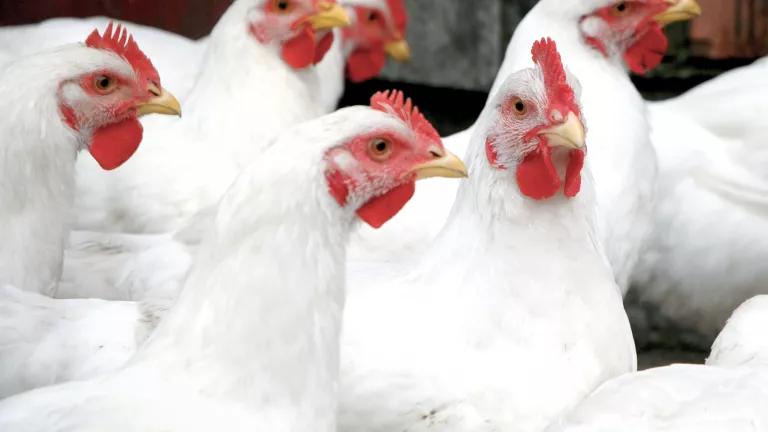Subway Cleans Up Its Chicken Game
NRDC helped get the world’s second-largest restaurant chain out of the antibiotics business.

Subway restaurants announced a plan in October 2015 to eliminate antibiotics from their supply chain. They will stop buying chicken raised with antibiotics by the end of 2016, and by 2025, they will stop serving meat from other types of animals that have been given the drugs. As welcome as the news was, it told only part of a much longer story: Behind the scenes, NRDC and its allies played an instrumental role in calling Subway’s attention to the threat of antibiotic resistance and, ultimately, persuading the company to tackle the problem head-on.
NRDC has long been committed to the fight to minimize the use of antibiotics in raising livestock. Around the world, people are experiencing a surge in drug-resistant infections, and there is reason to believe that the practice of feeding antibiotics to factory-farmed animals to promote growth and prevent infection contributes to the problem.
In 2015, a team of NRDC advocates focused its attention on Subway sandwich shops. “It’s a brand based on a healthy image,” says Jonathan Kaplan, director of NRDC’s Food and Agriculture program. “They’re also the most ubiquitous fast-food chain in America, with more locations than even McDonald’s [although McDonald's leads in sales]." The team began by writing a letter asking Subway’s leadership for a commitment to eliminate the routine use of antibiotics from its supply chain. Then they waited.
When it became clear that the company didn’t intend to respond, NRDC turned up the volume by recruiting partners. How many major organizations could Subway ignore? A lot of them, it turned out. A total of 58 high-profile advocates and public interest groups—including the Center for Food Safety, the Consumers Union, the U.S. Public Interest Research Group, and Friends of the Earth—joined NRDC in sending a second letter to Subway in June. They reminded the fast-food chain that 70 percent of the antibiotics fed to livestock are also important to human medicine, and that many of Subway’s peers, such as McDonald’s and Panera Bread, had already committed to cutting back on antibiotic use.

But Subway didn’t seem to be checking its mail, so the coalition looked for different ways to communicate. We put up a billboard across the highway from Subway’s headquarters in Milford, Connecticut. We launched a social-media campaign to involve NRDC members, supporters of the other coalition groups, and all their friends. Imagine if your Twitter feed were full of this kind of stuff.
Apparently feeling the pressure, Subway floated a trial balloon last August. An unnamed company official told the industry publication Nation’s Restaurant News that the chain had “plans to switch to chicken raised without human antibiotics” by 2016 and was working on antibiotic-free options for its other meats. “They said vaguely that they supported the elimination of subtherapeutic antibiotics,” meaning antibiotics not intended to treat a disease, “but they had no timeline,” Kaplan says. “That wasn’t a real commitment, so we kept campaigning.”
Since Subway declined even to take a call from the advocates, a petition came next. More than 30,000 of NRDC’s online supporters, plus tens of thousands from our partner groups, urged the company to change its policies. NRDC notified Subway executives that it planned to hand-deliver the petition to the company’s headquarters, accompanied by camera-toting reporters.
The day before the event, Kaplan’s phone began to ring. “Reporters were calling us to get our take on Subway’s new antibiotics policy,” he says. “That’s how we found out about the change.”
Subway went even further than the NRDC-led coalition had asked. The company committed to eliminate all antibiotics by 2025, not just those used for nontherapeutic reasons, from its entire supply chain, beginning with chicken in 2016. If an animal in the supply chain becomes sick and requires treatment with antibiotics—a use that NRDC supports—it is expected that the animal will be sold to another company. By adopting a no-antibiotics-ever standard, Subway is giving consumers, and its competitors, a clear message about the chicken it buys.
Kaplan credits the campaign’s success to an important decision made early in the process: to press the company to make changes that were easily within its power. “We ask restaurants to start with chicken because the poultry industry is already generating so much antibiotic-free meat—more than four times what it produced just three or four years ago,” he says.
Another crucial decision was to involve NRDC’s membership and supporters of our partner organizations. It’s easy enough to ignore a couple of letters from do-gooders, but when hundreds of thousands of potential customers say they want a change, it means the clock is ticking.
Speaking of ticking clocks, do you hear that sound, other chicken purveyors of America?
This NRDC.org story is available for online republication by news media outlets or nonprofits under these conditions: The writer(s) must be credited with a byline; you must note prominently that the story was originally published by NRDC.org and link to the original; the story cannot be edited (beyond simple things such as grammar); you can’t resell the story in any form or grant republishing rights to other outlets; you can’t republish our material wholesale or automatically—you need to select stories individually; you can’t republish the photos or graphics on our site without specific permission; you should drop us a note to let us know when you’ve used one of our stories.

Can't Beat 'Em? Eat 'Em
In Planning for Climate Change, Native Americans Draw on the Past
The Smart Seafood and Sustainable Fish Buying Guide